Let’s roll with the punches as we explore the exciting world of tire coding. Yes, exciting! Because who doesn’t enjoy a good deciphering session of seemingly cryptic tire codes?
Just as Samuel Morse telegraphed his way into history, tire manufacturers are quietly coding away, transmitting essential information about their products directly onto the sidewalls.
The tire industry has crafted its own unique language, and today, we’re going to crack some of it for you. So, fasten your seatbelts and hold on to your hubcaps!
What do 118t, 118s, 118q, 118h, 118r, 118v, 118w mean on a tire?
These seemingly obscure codes are not passwords to a secret tire society; rather, they denote vital details about your tire’s performance capabilities. The “118” component is a load index, referring to the maximum load that the tire can carry when fully inflated, and it corresponds to a specific weight. The letter that follows, whether it’s a T, S, Q, H, R, V, or W, is the tire’s speed rating, indicating the maximum speed the tire can safely maintain over time.
Let’s decipher the tire code with a helpful table:
| Load Index (118) | Corresponding Load (Kg) | Speed Rating | Maximum Speed (Km/h) |
| 118 | 1320 | T | 190 |
| 118 | 1320 | S | 180 |
| 118 | 1320 | Q | 160 |
| 118 | 1320 | H | 210 |
| 118 | 1320 | R | Restricted to Special Applications |
| 118 | 1320 | V | 240 |
| 118 | 1320 | W | 270 |
What does 118T mean on a tire?

Ah, 118T, the type of tire that would probably take you on a leisurely Sunday drive through the countryside. When you see “118T” on a tire, you’re looking at a model that can safely carry up to 1320 Kg of load when properly inflated (remember, overloading can be as hazardous as texting while driving) and can endure speeds of up to 190 km/h (roughly 118 mph, not that we’re encouraging such velocity!). Let’s break this down:
Load Index – 118
- The “118” signifies the tire’s load index.
- It refers to the maximum weight the tire can carry safely.
- For 118, that maximum load is 1320 Kg.
Speed Rating – T
- Following the load index is a letter representing the speed rating – “T” in this case.
- This indicates the maximum speed the tire can sustain for a certain period without risking failure.
- A “T” speed rating means the tire can safely maintain speeds up to 190 km/h.
What does 118S mean on a tire?
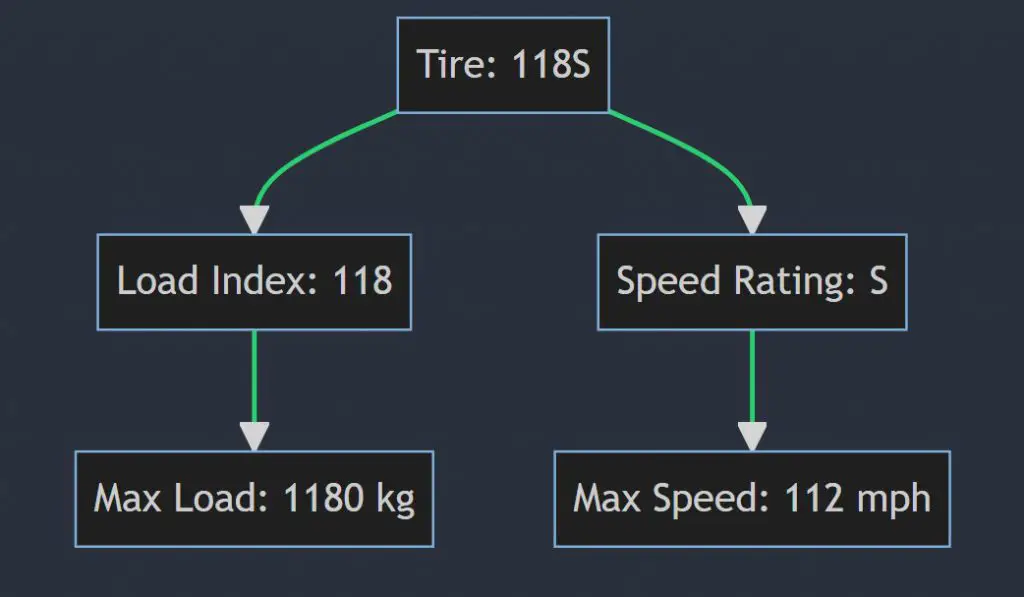
Now, let’s say hello to the 118S tire, the tire equivalent of your trusty, reliable family station wagon. With a “118S” rating, your tire can support a load of up to 1320 Kg and can handle speeds of up to 180 km/h, making it a reliable choice for most family vehicles and SUVs. Let’s dig into the details:
Load Index – 118
- The load index, represented by “118”, stands for the maximum load the tire can bear.
- For the “118” load index, that maximum load is, once again, 1320 Kg.
Speed Rating – S
- The “S” in “118S” represents the tire’s speed rating.
- It’s a measure of the maximum safe speed the tire can handle over an extended period.
- An “S” speed rating corresponds to a maximum speed of 180 km/h.
Remember, having the knowledge of what these codes mean doesn’t give you the license to load up your vehicle and speed off into the sunset. Always drive responsibly because the life you save may be your own… or your tire’s!
What does 118Q mean on a tire?
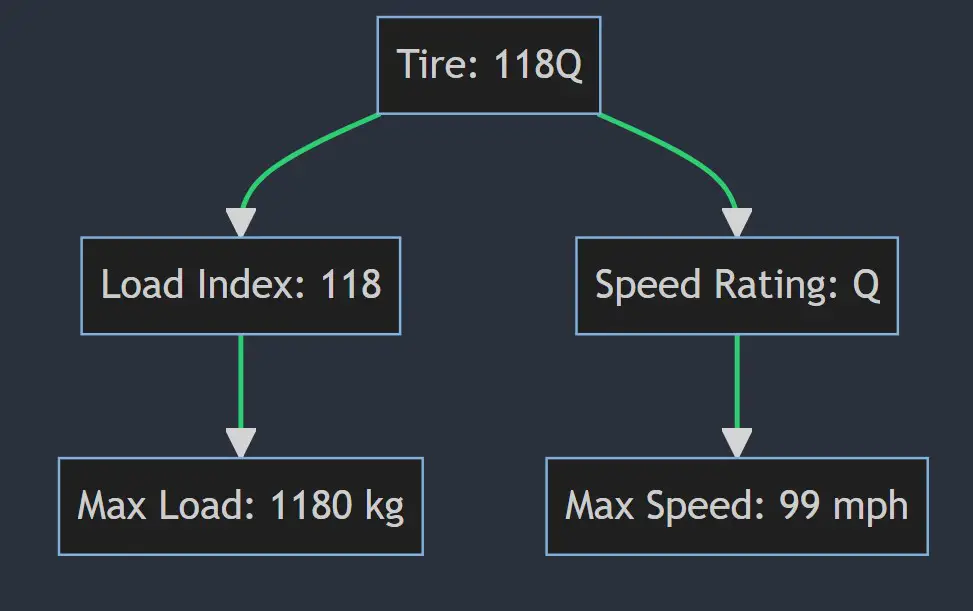
Moving on to the world of 118Q, the type of tire that might accompany you on a serene drive through a snowy winter landscape. With a “118Q” rating, your tire can lug up to 1320 Kg and maintain a maximum speed of 160 km/h. It’s a strong choice for vehicles navigating colder climates and requiring tires for snow or mud use. Let’s dig into these frosty details:
Load Index – 118
- “118” stands for the load index, indicating the tire’s weight-bearing capabilities.
- For a tire with a load index of “118”, the maximum weight it can handle is 1320 Kg.
Speed Rating – Q
- The “Q” signifies the tire’s speed rating.
- It reflects the highest speed that the tire can sustain over a specified period without risking failure.
- A tire with a “Q” speed rating can safely handle speeds up to 160 km/h.
Remember, snowflakes are beautiful, but speeding in a snowstorm is not! Keep your speeds moderate and stay safe out there.
What does 118H mean on a tire?
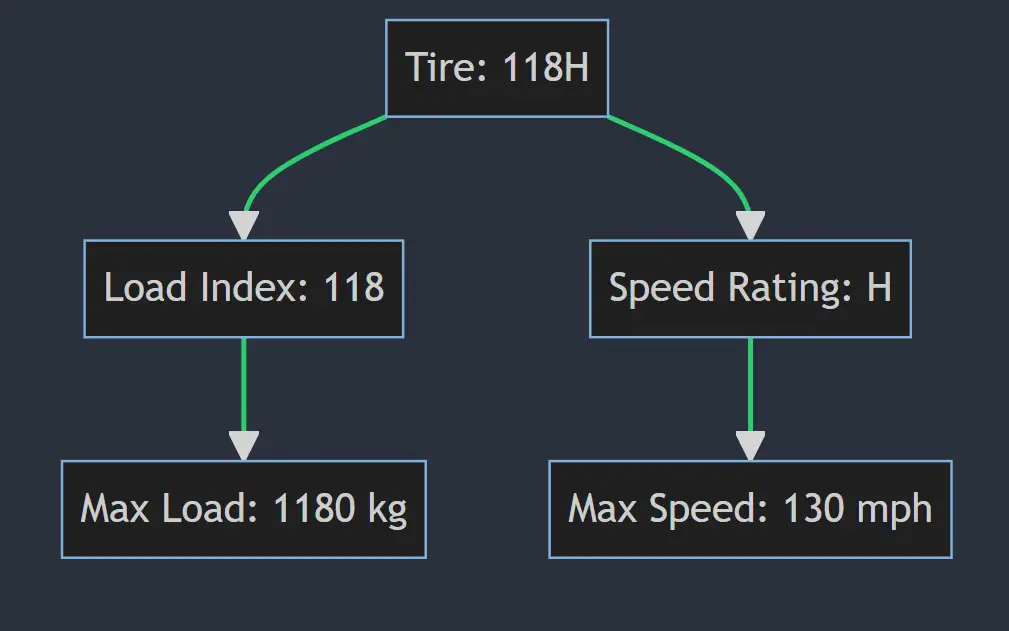
Ah, the 118H, a tire that’s eager to hit the highway and feel the wind in its treads. When you see a “118H” on a tire, it signifies that it can carry up to 1320 Kg and can safely maintain speeds up to 210 km/h. It’s a common choice for many sedans and sporty coupes.
Load Index – 118
- The “118” represents the tire’s load index.
- It denotes the maximum weight the tire can carry safely.
- For 118, that maximum load is 1320 Kg.
Speed Rating – H
- Following the load index is a letter representing the speed rating – “H” in this case.
- This indicates the maximum speed the tire can maintain for a certain duration without risking failure.
- An “H” speed rating means the tire can safely maintain speeds up to 210 km/h.
Highways and byways may call, but remember, speed thrills but also kills. Keep your speeds in check and your journey enjoyable.
What does 118R mean on a tire?
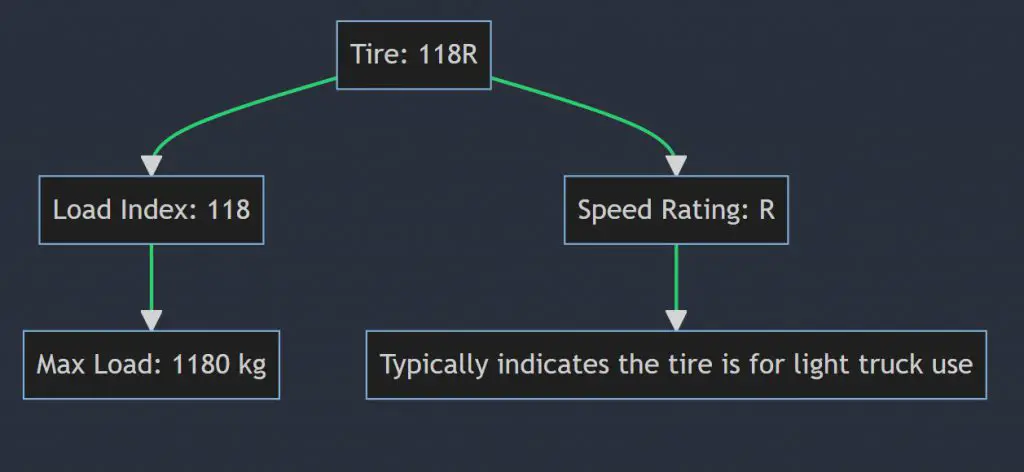
Finally, we come to the unique 118R. This tire can support a load of up to 1320 Kg. The “R” in this context typically denotes a radial design, not a speed rating.
Load Index – 118
- Here, “118” still represents the tire’s load index.
- It corresponds to the maximum weight the tire can safely carry, which for 118 is 1320 Kg.
Tire Design – R
- In this context, the “R” does not represent a speed rating. Instead, it refers to the tire’s construction type – radial.
- Radial tires feature layers of fabric with cords running perpendicular to the tread direction, offering stability and durability.
Remember, understanding your tire means understanding safety. Keep that in mind, and you’ll always be rolling in the right direction. Happy driving!
What does 118V mean on a tire?
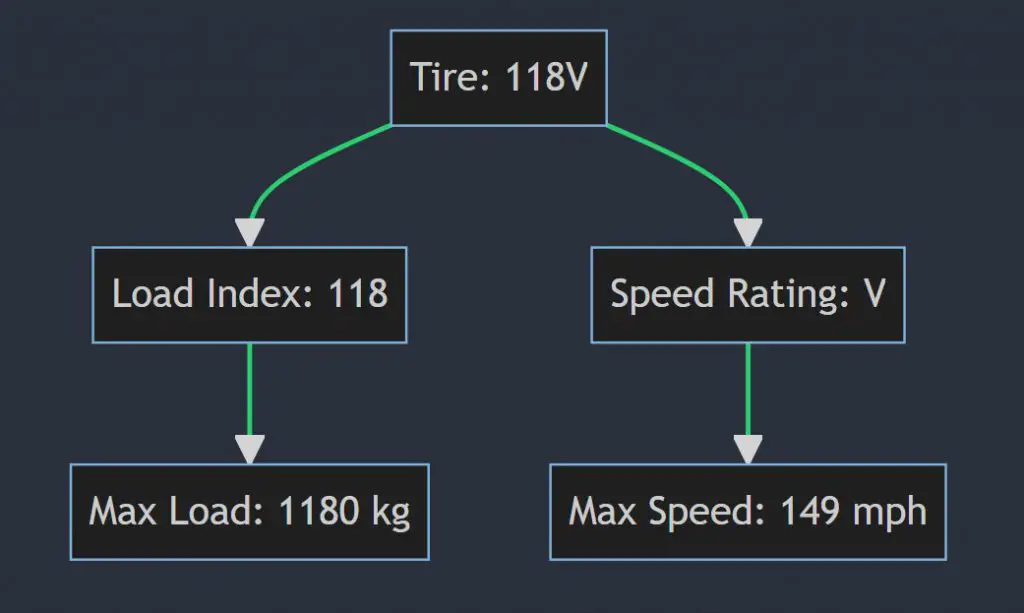
Let’s shift gears and speed into the 118V lane. When you see a “118V” on a tire, it means the tire can hold a load up to 1320 Kg and can safely maintain a speed up to 240 km/h. These kinds of tires are typically found on performance-oriented sedans and sporty coupes. Buckle up as we break it down:
Load Index – 118
- “118” denotes the tire’s load index.
- This number indicates the maximum weight the tire can safely bear.
- For a tire with a load index of “118”, this maximum load is 1320 Kg.
Speed Rating – V
- The “V” following the load index represents the tire’s speed rating.
- This rating gives you the tire’s maximum safe speed.
- For a tire with a “V” speed rating, this maximum speed is 240 km/h.
Remember, driving fast is not necessarily driving smart. Stay within speed limits and ensure your driving is as top-notch as your tire’s speed rating.
What does 118W mean on a tire?
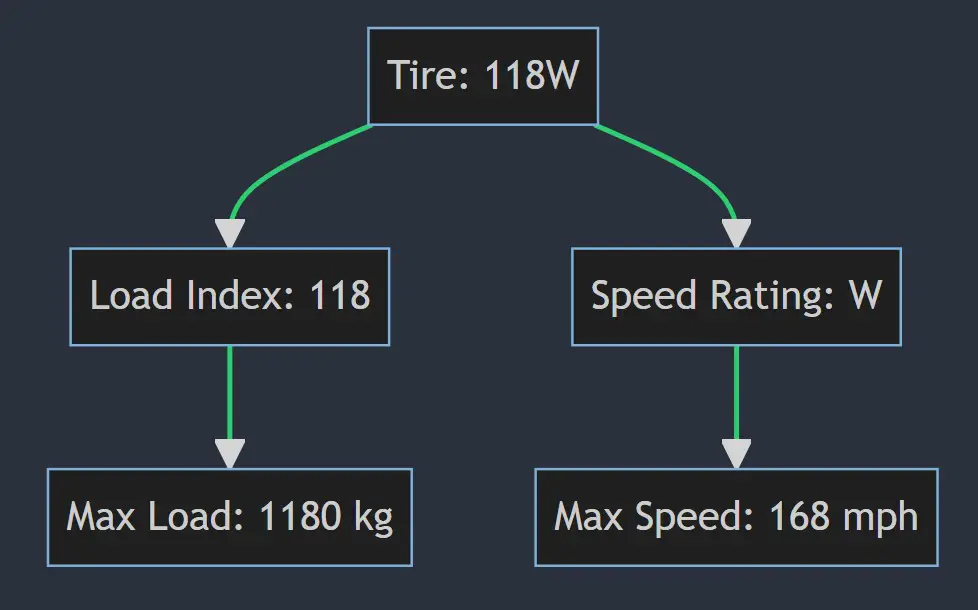
Finally, revving into the fast lane, we have the 118W. This tire code means the tire can bear a load of up to 1320 Kg and is rated for speeds up to 270 km/h. They’re typically used for high-performance vehicles and supercars.
Load Index – 118
- The “118” indicates the tire’s load index.
- This number refers to the maximum weight the tire can carry.
- For a tire with a load index of “118”, the maximum load it can handle is 1320 Kg.
Speed Rating – W
- The “W” symbolizes the tire’s speed rating.
- This rating shows the highest speed the tire can maintain over a certain duration without risking failure.
- A tire with a “W” speed rating can safely maintain speeds up to 270 km/h.
Just because your tires can handle these speeds doesn’t mean you should constantly test these limits. As the adage goes, “With great power comes great responsibility.” So drive responsibly and let your tires do their job without pushing them to the extreme. Keep the “wheely” bad puns and the high speeds on the track!
FAQs
What does 121/118R mean on a tire?
The code 121/118R on a tire holds specific information about the tire’s load capacity and its construction. The first number, 121, is the load index for a single tire. In this case, it means the tire can safely support a load of 1450 Kg when fully inflated. The second number, 118, is the load index when the tires are used as a pair, like in a dual rear wheel setup. So, when used as a pair, each tire can support 1320 Kg. The “R” in this code stands for Radial, indicating the tire’s construction type.
118R vs 118S: What’s the difference?
The difference between 118R and 118S lies in the last letter, which denotes the speed rating of the tire in the case of 118S, and the tire’s construction in the case of 118R. An 118S rated tire can safely handle speeds up to 180 km/h, while the “R” in 118R signifies that the tire is of Radial construction. It’s important to note that in the context of 118R, the “R” is not a speed rating.
118Q vs 118H: How do they compare?
The difference between 118Q and 118H is the maximum speed the tires can safely handle. Both can support the same weight of 1320 Kg (as denoted by the “118”), but the “Q” rated tire can safely maintain speeds up to 160 km/h, whereas the “H” rated tire can sustain speeds up to 210 km/h. So, essentially, an 118H tire can handle higher speeds than an 118Q.
Recap and Summary
In our rubber-filled journey today, we’ve decoded the meaning of 118T, 118S, 118Q, 118H, 118R, 118V, and 118W as they appear on a tire. The “118” refers to the load index of the tire, which is the maximum weight the tire can carry when fully inflated. This load is 1320 Kg for a tire with an index of 118.
The letters that follow – T, S, Q, H, R, V, W – are a mixed bag. They mostly represent speed ratings, telling you the top speed the tire can safely maintain. For T, it’s 190 km/h; for S, it’s 180 km/h; Q represents 160 km/h; H, a highway-friendly 210 km/h; V takes it up a notch to 240 km/h; and W tops the chart with a whopping 270 km/h.
The outlier in this case is R. While it might seem like another speed rating, it’s not. Instead, it signifies the tire’s construction – radial, to be precise.
In essence, these codes are not just random combinations but concise summaries of your tire’s capacity and capability. Understanding them can help you choose the right tire for your needs and drive with confidence, knowing exactly what your tire can handle.
Remember, knowledge is power, but with this newfound power, it’s important to drive responsibly. So keep your tires inflated, your eyes on the road, and your mind on safety. After all, it’s not about the destination but the journey – so make sure your journey is a safe one. Happy motoring!
Alternative Tire Size Codes of Similar Specifications

AR Jeet has been a tire mechanic for over 2years. He has worked on all types of vehicles, from cars and trucks to RVs and ATVs and motorcycles. He has seen it all when it comes to tires, and he knows how to fix them.
AR Jeet is a tire expert, and he is passionate about his work. He loves to help people keep their vehicles running smoothly, and he is always happy to answer any questions that people have about their tires.
If you need help with your tires, or if you just want to learn more about them, then AR Jeet is the man to talk to. He will be happy to help you out, and he will make sure that you get the best possible solution.
He has a blog [Tirespick.com] where he writes about all things tire-related, and he is always happy to help people with their tire needs. Know more about AR Jeet.
